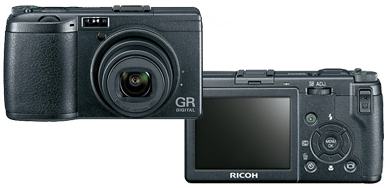
When planning the GR Digital, Ricoh’s engineers began by identifying the elements that provide the high picture quality demanded by discerning photographers. After much study, Ricoh placed special emphasis on resolution, noise level, color aberration correction, color reproduction, tone, and distortion characteristics. In order to achieve extremely high levels in each of these areas, Ricoh gave the GR Digital a CCD with 8,130,000 effective pixels, and also developed two key components: (1) a F2.4 fixed focal length GR lens with f = 5.9 mm (28 mm converted to 35 mm format camera) having high resolution and depictive power; and (2) a new GR Engine image-processing system featuring natural composition and rich, fine gradations while further lowering noise in all images.
These key components in turn translate into a high Modulation Transfer Function (MTF) rating for the central area of the image as well as the edges. MTF is a measure of contrast and resolution, and one of the most widely used standards for evaluating image quality. The GR Digital has the descriptive power to show each hair on a person's head, with superb reproductive capability all the way into the corners of the picture. The GR Digital’s images also reduce noise, giving greater continuity in dark areas, reproduces natural tones and gradations, and reduces blurring and distortion.
| Item | Description | ||||||||
| CCD | Effective 8.13 million pixels (8.30 million pixels), 1/1.8-inch primary-color CCD | ||||||||
| Lens |
|
||||||||
| Shutter |
|
||||||||
| Picture Mode | Fine, Normal, RAW(DNG)*3 | ||||||||
| Exposure Adjustment | TTL-CCD photometric system: Multi (256 segments), Center Weight, Spot | ||||||||
| White Balance | Auto/Fixed (Daylight, Overcast, Tungsten Light, Fluorescent Light, Manual, Advanced), White Balance-bracket function | ||||||||
| Recording Media | SD Memory CardTM(3.3V 32/64/128/256/512MB/1GB), Multi Media CardTM, Built-in Memory 26MB | ||||||||
| Recording Mode | Photo (Still, Continuous, S-Continuous, M-Continuous), Program Shift/Aperture-Priority/Manual exposure, Scene (Text, Sound), Motion | ||||||||
| Recording Formats |
|
||||||||
| LCD Monitor | 2.5 inch low temperature polysilicon TFT LCD (approx. 210,000 pixels) | ||||||||
| Dimensions (W x D x H) | 107.0 x 25.0 x 58.0 mm (excluding projections) | ||||||||
| Weight | Approx. 170g (excluding
battery, SD Memory Card, hand strap), Accessories (battery, hand strap) approx. 30g |
||||||||
| Power Source | Rechargeable Battery (DB-60) x
1, AC adaptor (AC-4c), AAA Battery (alkaline/oxyride/NiMH rechargeable battery) x 2 |
||||||||
| Shooting Capacity |
|
||||||||